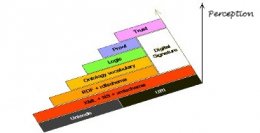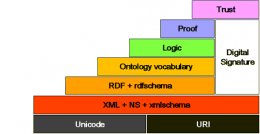What is Semantic Web?
Many people don't have a clear idea of what the Semantic Web is. The best informal definition is maybe found in the May 2001 Scientific American article "The Semantic Web" (Berners-Lee et al.), that says "The Semantic Web is an extension of the current web in which information is given well-defined meaning, better enabling computers and people to work in cooperation." People who work on the Semantic Web have a more detailed idea of what this broad statement means, and base their work on the famous "semantic web tower", a product of Tim Berners-Lee's inspiring drawing on whiteboards. Even if you are not a geek, you might have read some article on the semantic web, or followed some presentation, and then you will surely have met the tower, which is a drawing like this
The article or presentation might have then continued by explaining what the "layers" of this tower are, starting from the basic bricks (Unicode and URIs), up to XML, and then up to more and more sophisticated layers like RDF, Ontology and so on.
 Now, you might have understood how things work, and have been eagerly awaiting for the realization of this plan. Or, you might not have understood this quite, and have been waiting for someone to show you better what they meant. In fact, the plan as shown in the picture is rapidly taking place: many of the slots are filling up (RDF, RDF Schema, Ontology, Digital Signature). So, the picture as shown is getting completed. Still, most of the people are awaiting, and the Semantic Web has not yet taken off. What's the matter here?
Now, you might have understood how things work, and have been eagerly awaiting for the realization of this plan. Or, you might not have understood this quite, and have been waiting for someone to show you better what they meant. In fact, the plan as shown in the picture is rapidly taking place: many of the slots are filling up (RDF, RDF Schema, Ontology, Digital Signature). So, the picture as shown is getting completed. Still, most of the people are awaiting, and the Semantic Web has not yet taken off. What's the matter here?
The matter comes from the definition of Semantic Web that we have seen earlier: "The Semantic Web is an extension of the current web in which information is given well-defined meaning, better enabling computers and people to work in cooperation." Now, the sole fact that the tower is filling up with established standards corresponds to the first part of the definition, "an extension of the current web". The fact that these standards work corresponds to a piece of the second part of the definition: "enabling computers to work in cooperation". What is missing, is maybe the most crucial part of the definition: the people. Those people who are awaiting.
You might also like



|
Der Tod als Text und Signum: Der literarische Todesdiskurs in geistlich-didaktischen Texten des Mittelalters (Deutsche Literatur von den Anfängen bis 1700) (German Edition) Book (Peter Lang) |








